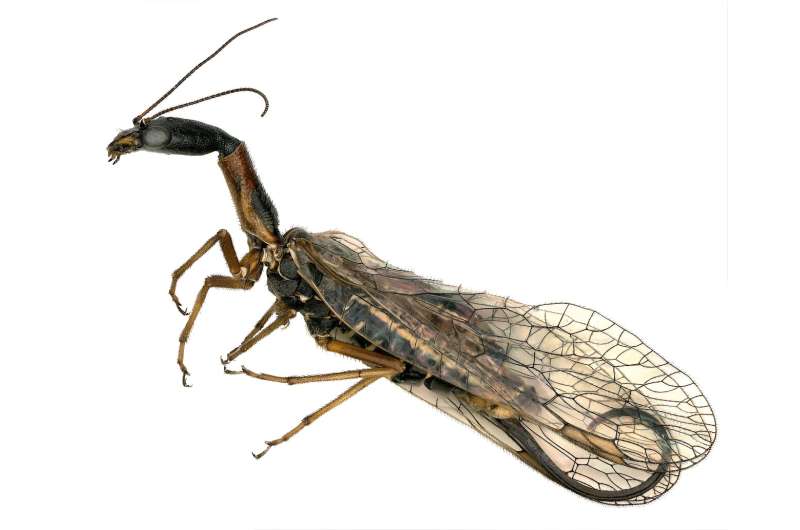
This snake fly belongs to the genus Agras and is one of 400 species of insects found in the backyards and byways of Los Angeles. Photo by Lisa Gonzalez, courtesy of Natural History Museum of Los Angeles County, CC BY-SA
The most important predictors of insect biodiversity in Los Angeles are its proximity to mountains and its stability of temperatures throughout the year, according to the study, co-authored by Brian V. Brown of the Natural History Museum of Los Angeles County and colleagues from the University of Southern California and California State University.
The project used data from the museum’s BioSCAN project, which allowed volunteers across Los Angeles to set up insect traps on the grounds between 2014 and 2018.
The analysis showed some unexpected results. For example, land value had little effect on the overall diversity of arthropods, such as spiders and insects. This finding calls into question the “luxury hypothesis” – the notion that wealthy areas, which tend to have more trees, always have higher biodiversity. This hypothesis applies generally to birds and mammals, including bats.
BioSCAN research has identified more than 400 insect species throughout the greater Los Angeles area, many of which have survived despite paving over and habitat loss.
Indeed, urban environments can be attractive to some invasive arthropod species. Such species, often called urban opportunists, often arrive in waves, replacing or limiting incumbent species. For example, about 20 years ago, Los Angeles’ endemic black widow spider (Latrodectus hesperus) began to be replaced by brown recluse spiders (Latrodectus geographicus). Recent evidence suggests that these invaders are now being replaced by the noble false brown recluse spider (Steatoda nobilis).
Why it matters
Insects are essential to humans, we depend on them for pollination, to break down plant and animal matter and to control pests – services that are important in cities and rural areas alike, and which insects provide free of charge.
Imagine a city where organic waste, such as dead animals and plant matter, never decomposes. A city without insects would mean an environment without birds and most other types of wildlife that rely on insects for food. No flowers, fruits or vegetables would grow in such an environment. In fact, a world without insects is a world without humans.

Arthropod species richness in Los Angeles. Black dots indicate locations where the BioSCAN project collected insects between 2014 and 2018. The color scale indicates the predicted number of species, with blue being the least abundant and orange being the most abundant. Credit: Map tile by Stamen Design, CC BY-SA
Low arthropod diversity can lead to ecosystem imbalances: A 2022 study found that pests like sap-feeding aphids can get out of control in urban areas because there aren’t enough predators like beetles or spiders to keep them in check.
While most biodiversity research takes place in natural or protected areas, scientists are increasingly realizing that urban areas can also harbor many species. Understanding urban biodiversity is important because cities are expected to continue to expand, with the United Nations predicting that urban populations will increase by 2.5 billion people by 2050.
What we don’t know yet
Although we now know what factors most strongly influence arthropod diversity in Los Angeles, how this diversity translates to a healthy urban ecosystem is not fully understood.
Scientists know that more species mean healthier urban ecosystems, but not all species contribute equally. For example, planting pollinator-friendly plants is a relatively simple intervention in urban environments, but it doesn’t benefit all insect species.
What’s next?
As part of the BioSCAN project, volunteers have also allowed bioacoustic monitors to be installed on the site, so future studies can include bats, which are also essential for urban pollination and pest control.
Additionally, researchers at the University of Southern California are continuing to study the same dataset to understand seasonality in urban arthropod communities. As the climate warms, this knowledge could help predict future changes in insect populations.
Overall, insights gained from these studies could inform urban planning and development to support insect biodiversity, especially as cities expand due to urban sprawl.
Courtesy of The Conversation
This article is republished from The Conversation under a Creative Commons license. Read the original article.![]()
Source: Bugs thrive in urban Los Angeles – Volunteer traps reveal urban insect and spider biodiversity hotspots (July 22, 2024) Retrieved July 22, 2024 from https://phys.org/news/2024-07-bugs-urban-los-angeles-volunteers.html
This document is subject to copyright. It may not be reproduced without written permission, except for fair dealing for the purposes of personal study or research. The content is provided for informational purposes only.

